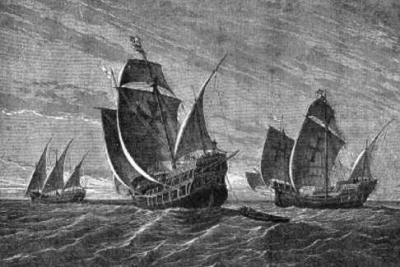A letter written by Christopher Columbus on February 15, 1493 is the first known document announcing the results of his first voyage that set out in 1492 and reached the Americas. The letter was ostensibly written by Columbus himself, aboard the caravel Nia, on the return leg of his voyage. A postscript was added upon his arrival in Lisbon on March 4, 1493, and it was probably from there that Columbus dispatched two copies of his letter to the Spanish court.
The letter was instrumental in spreading the news throughout Europe about Columbus's voyage. Almost immediately after Columbus's arrival in Spain, printed versions of the letter began to appear. A Spanish version of the letter (presumably addressed to Luis de Santngel), was printed in Barcelona by early April 1493, and a Latin translation (addressed to Gabriel Snchez (tesorero)) was published in Rome around a month later (ca. May 1493). The Latin version was swiftly disseminated and reprinted in many other locationsBasel, Paris, Antwerp, etc.still within the first year of his arrival.
In his letter, Christopher Columbus claimed to have discovered and taken possession of a series of islands on the edge of the Indian Ocean in Asia; Columbus was not aware that he had stumbled upon a new continent. He described the islands, particularly Hispaniola and Cuba, exaggerating their size and wealth, and suggested that mainland China probably lay nearby. He also gave a brief description of the native Arawaks (whom he called "Indians"), emphasizing their docility and amenability, and the prospects of their conversion to Catholicism. However, the letter also revealed local rumors about a fierce man-eating tribe of "monsters" in the area (probably Caribs), although Columbus himself disbelieved the stories, and dismissed them as a myth. The letter provides very few details of the oceanic voyage itself, and covers up the loss of the flagship of his fleet, the Santa Mara, by suggesting Columbus left it behind with some colonists, in a fort he erected at La Navidad in Hispaniola. In the letter, Columbus urges the Catholic monarchs to sponsor a second, larger expedition to the Indies, promising to bring back immense riches.
A slightly different version of Columbus's letter, in manuscript form, addressed to the Catholic monarchs of Spain, was found in 1985, part of the Libro Copiador collection, and has led to some revision of the history of the Columbus letter.The two earliest published copies of Columbus's letter on the first voyage aboard the Nia were donated in 2017 by the [[Jay I. Kislak Foundation to the University of Miami library in Coral Gables, Florida, where they are housed.
La Niña (Spanish for The Girl) was one of the three Spanish ships used by Italian explorer Christopher Columbus in his first voyage to the West Indies in 1492. As was tradition for Spanish ships of the day, she bore a female saint's name, Santa Clara. However, she was commonly referred to by her nickname, La Niña, which was probably a pun on the name of her owner, Juan Niño of Moguer. She was a standard caravel-type vessel.
The other ships of the Columbus expedition were the caravel-type Pinta and the carrack-type Santa María. Niña was by far Columbus's favorite. She was originally lateen sail rigged caravela latina, but she was re-rigged as caravela redonda at Las Palmas, in the Canary Islands, with square sails for better ocean performance. There is no authentic documentation on the specifics of Niña's design, although Michele de Cuneo, who accompanied Columbus on his second voyage, mentioned that Niña was "about 60 toneladas" (60 tons), which may indicate a medium-sized caravel of around 50 feet (15 m) in length on deck. Often said to have had three masts, there is some evidence she may have had four masts.Niña, like Pinta and Santa María, was a smaller trade ship built to sail the Mediterranean sea, not the open ocean. It was greatly surpassed in size by ships like Peter von Danzig of the Hanseatic League, built in 1462, 51 m (167 ft) in length, and the English carrack Grace Dieu, built during the period 1420–1439, weighing between 1,400 and 2,750 tons, and 66.4 m (218 ft) long, in both weight and length.

1493Feb, 15
While on board the Niña, Christopher Columbus writes an open letter (widely distributed upon his return to Portugal) describing his discoveries and the unexpected items he came across in the New World.
Choose Another Date
Events on 1493
- 15Feb
Columbus's letter on the first voyage
While on board the Niña, Christopher Columbus writes an open letter (widely distributed upon his return to Portugal) describing his discoveries and the unexpected items he came across in the New World. - 4Mar
Voyages of Christopher Columbus
Explorer Christopher Columbus arrives back in Lisbon, Portugal, aboard his ship Niña from his voyage to what is now The Bahamas and other islands in the Caribbean. - 4May
New World
Pope Alexander VI divides the New World between Spain and Portugal along the Line of Demarcation. - 3Nov
Dominica
Christopher Columbus first sights the island of Dominica in the Caribbean Sea. - 18Nov
Puerto Rico
Christopher Columbus first sights the island now known as Puerto Rico.

 English
English  español
español  français
français  português
português  русский
русский  العربية
العربية  简体中文
简体中文 